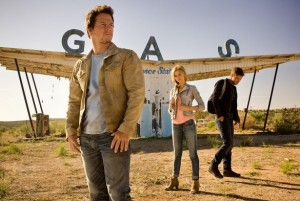Transformers: Age of Extinction: Stars feel the heat of real explosions
By Richard Crouse – Metro Canada
“We were happy to do whatever was asked of us whenever it was asked of us,” says Transformers: Age of Extinction star Jack Reynor.
The Colorado-born, Irish-raised actor proved he was game for anything when he was given just twenty minutes to prepare for a wild scene that brought him face-to-face with real explosions.
“It is an incredibly intimidating experience in many ways,” he said, “but at the end of the day you have to trust the people around you, that they know what they’re doing that they’re prepared and that you’re safe. We had a great stunt team who worked on this film with us. Those guys really put us at ease.”
Sharing the explosive scene with Reynor were his co-stars Nicola Peltz and Mark Wahlberg.
“They worked so hard to make this huge explosion,” says Peltz, best known for her role as Bradley Martin on Bates Motel. “I think it took a week but we didn’t know about it. We were kind of confused when we got on set and saw ten cameras. (Director) Michael (Bay) told us a few minutes before, ‘You’re going to do this huge stunt. It’s not going to be stunt doubles, it’s going to be you guys and you have to run from here to here in 4.6 seconds.’
“There’s not much acting when there are real explosions behind you,” she says. “You just have to run.”
The experience of sprinting away from live blasts wasn’t exactly what Peltz expected when she signed on for the role in the fourth Transformers film.
“I thought there was going to be more green screen than there actually was but Michael wants everything to be as real as possible so the car chases and the explosions are all real.”
“You can really tell the difference,” says Reynor. “You can tell when a movie is really heavy on CG. It doesn’t really look real. As far as we’ve come with effects and all the advancements we’ve made—some of them are really great—at the end of the day to do it practically and do it for real always looks best on screen. That’s why Michael tries to make it that way. On top of that it makes everything more tangible for us; a lot easier to relate to and react off. That’s why I think these movies have been as incredibly successful as they have because the audience really does feel it.”

